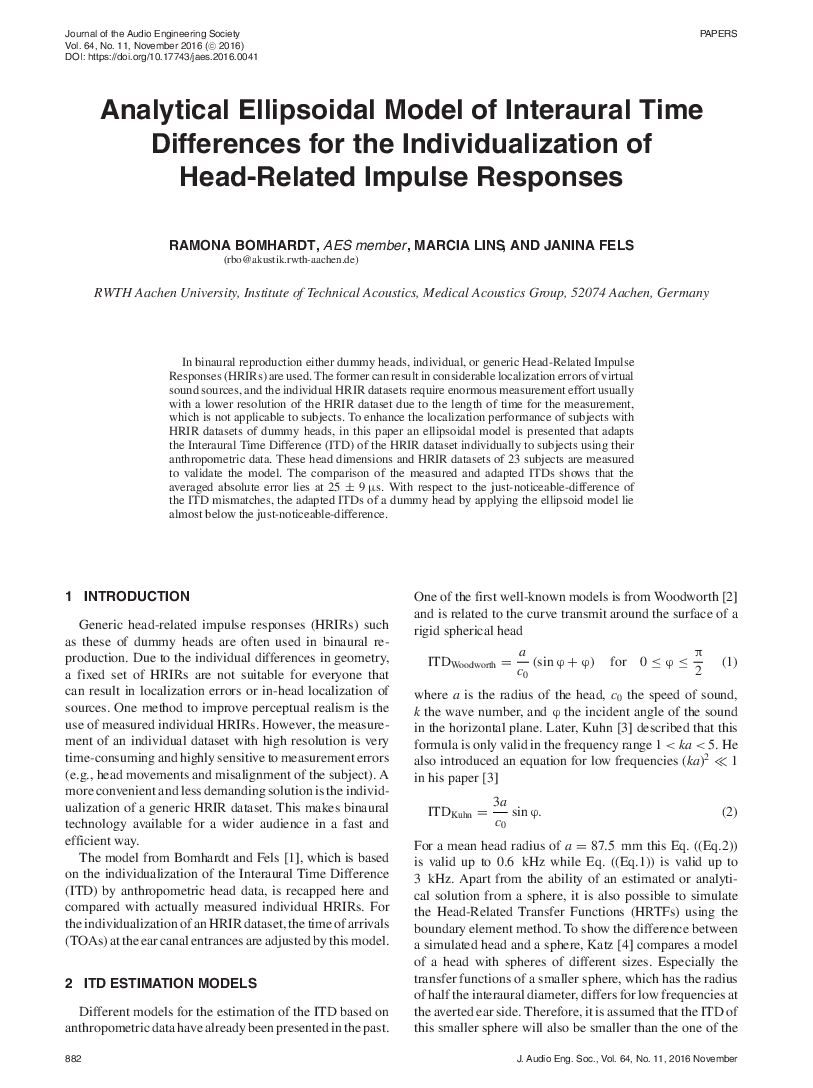Home / Publications / E-library page
You are currently logged in as an
Institutional Subscriber.
If you would like to logout,
please click on the button below.
Home / Publications / E-library page
Only AES members and Institutional Journal Subscribers can download
To enhance the localization performance of listeners using head-related impulse responses HRIR datasets from dummy heads, individualization was added. An ellipsoidal model is used to adapt the Interaural Time Difference (ITD) of the dataset to individual subjects by using their anthropometric data. Head measurements from 23 subjects were used to validate the model. The ITD model is based on an ellipsoid shape and the analytical solution of the sound transmission around a sphere. A comparison of the measured and adapted ITDs shows that the average absolute error was 25 +/- 9 µs, which is a value below the just-noticeable difference. However, the ellipsoidal model underestimates the ITD. In contrast to similar approaches, this model calculates both azimuth- and elevation-dependent ITDs. Since the ITD of a given HRTF dataset is individualized, the shoulder reflections and the ear offset are maintained.
Author (s): Bomhardt, Ramona; Lins, Marcia; Fels, Janina
Affiliation:
RWTH Aachen University, Institute of Technical Acoustics, Medical Acoustics Group, Aachen, Germany
(See document for exact affiliation information.)
Publication Date:
2016-11-06
Import into BibTeX
Permalink: https://aes2.org/publications/elibrary-page/?id=18525
(600KB)
Click to purchase paper as a non-member or login as an AES member. If your company or school subscribes to the E-Library then switch to the institutional version. If you are not an AES member Join the AES. If you need to check your member status, login to the Member Portal.

Bomhardt, Ramona; Lins, Marcia; Fels, Janina; 2016; Analytical Ellipsoidal Model of Interaural Time Differences for the Individualization of Head-Related Impulse Responses [PDF]; RWTH Aachen University, Institute of Technical Acoustics, Medical Acoustics Group, Aachen, Germany; Paper ; Available from: https://aes2.org/publications/elibrary-page/?id=18525
Bomhardt, Ramona; Lins, Marcia; Fels, Janina; Analytical Ellipsoidal Model of Interaural Time Differences for the Individualization of Head-Related Impulse Responses [PDF]; RWTH Aachen University, Institute of Technical Acoustics, Medical Acoustics Group, Aachen, Germany; Paper ; 2016 Available: https://aes2.org/publications/elibrary-page/?id=18525
@article{bomhardt2016analytical,
author={bomhardt ramona and lins marcia and fels janina},
journal={journal of the audio engineering society},
title={analytical ellipsoidal model of interaural time differences for the individualization of head-related impulse responses},
year={2016},
volume={64},
issue={11},
pages={882-894},
month={november},}
TY – paper
TI – Analytical Ellipsoidal Model of Interaural Time Differences for the Individualization of Head-Related Impulse Responses
SP – 882 EP – 894
AU – Bomhardt, Ramona
AU – Lins, Marcia
AU – Fels, Janina
PY – 2016
JO – Journal of the Audio Engineering Society
VO – 64
IS – 11
Y1 – November 2016